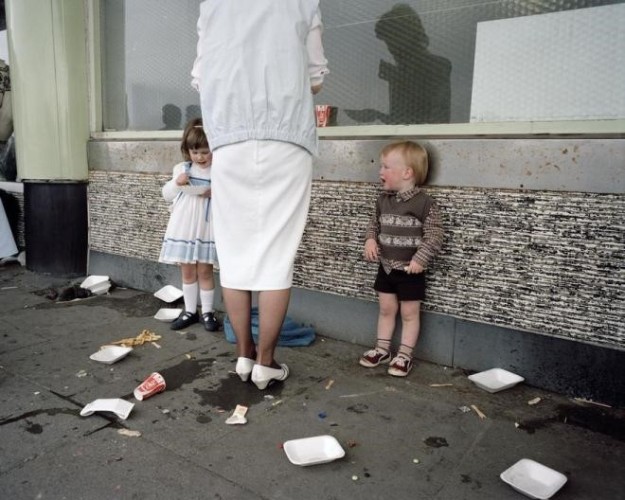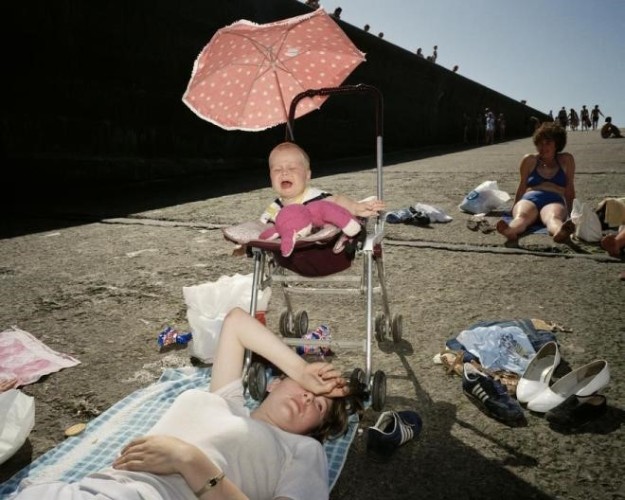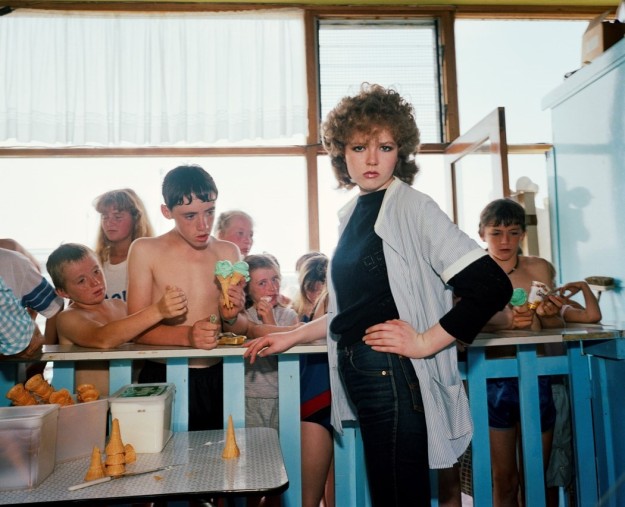My tutor has suggested in the last two of his reports on my assignments for this module my tutor that I look at the work of Martin Parr. In the past I resisted this because a few years ago while I was working through “The Art of Photography” module I wrote up some general notes on Parr’s work (TAOP- Martin Parr). As I am currently considering doing my fifth assignment about a traditional English seaside resort I decided to look at his book “The Last Resort” which contains picture taken in New Brighton in the early 1980s. This work is perhaps the work that established Parr as a photographer with a unique way of capturing British population at leisure. When it was shown in the Serpentine Gallery in London this work
became notorious and Parr received some extremely harsh reviews:
David Lee wrote: “(Parr) has habitually discovered visitors at their worst, greedily eating and drinking junk food and discarding containers and wrappers with an abandon likely to send a liberal conscience into paroxysms of sanctimony.” also “Only babies and children survive ridicule and it is their inclusion in many pictures which gives Parr’s acerbic vision of hopelessness its poetic touch.” and “Our historic working class, normally dealt with generosity by documentary photographers, becomes a sitting duck for a more sophisticated audience. They appear fat, simple, styleless, tediously conformist and unable to assert any individual identity.”
Robert Morris in the BJP wrote “This is a clammy, claustrophobic nightmare world where people lie knee-deep in chip papers, swim in polluted black ponds, and stare at a bleak horizon of urban dereliction.”
Interestingly when the work had been exhibited in Liverpool before the London show it had been well received and not generated the vitriol that the London critics engaged in. Indeed, over time the reaction to the work has become more positive. For example:
Val Williams in her 2002 retrospective of Parrs work wrote “So what was it about The Last Resort that so terrified and disgusted the people who wrote about it? There is some litter, admittedly, but it’s never knee-deep, and there are some fat people, but they’re not gargantuan and they’re not in the majority.
Elisabeth Mahoney wrote in the Guardian “At the time, Martin Parr’s series of photographs from New Brighton, a dilapidated seaside spot on the Wirral, were seen as condescending. But now they look humorously engaged and fond, bringing British working-class nooks and crannies into view, and reminding us how unusual that was (and is) in art photography.”
Looking at the work now nearly 30 years after they were taken and about fifteen years after it was re-assessed in Val William’s retrospective it almost seems that initial the work was hijacked to allow people to support the critics political viewpoints. On numerous occasions Parr has said in interviews that the work was not intended to be a cruel commentary on the then working classes rather he wanted to capture energy and litter of New Brighton.
In my summary below I have tried to walk through the book in sequence but I have not discussed every picture rather focus on the picture I particularly like and those that are typical of sequences of pictures with similar themes.
The Book starts with the image below showing a bored couple sitting in a restaurant. The man with a cigarette dangling from his month and the woman staring intently at her nails are clearly ill at ease. It almost seems like Parr has captured the moment after an argument when they are just trying hard just to ignore each other. As the first image in the book this photograph sets the tone for the work and is perhaps saying not everyone has fun at a seaside resort.

In the fourth picture in the book, the infamous litter referred to in exaggerated terms in some of the original reviews of the first London show appears. Here a mother with her head cut off but visible as a reflection and her two children are eating amongst discarded polystyrene food containers. The little girl looks happy the boy is obviously unhappy, perhaps he didn’t like his food or just wants more. I really like the cleaver composition showing the woman eating reflected in the window. There is also a distinct sense of grubbiness from both the litter and the obviously worn faced of the shop.

The next series of work in the book show adults engrossed with fruit machines and other coin operated machines while the children with them seem to be largely ignored and in some cases creating their own entertainment. I like the first picture in this sequence shown below I particularly like the way it captures the seediness of the amusement arcade and the way at first sight the adults playing the machine are staring almost hypnotised by it whereas the slow shutter makes it look like the child is moving around employing this new environment. Looking more deeply at the picture you can see a ghostly image of the arm of the second lady as she pressed the button to spin the wheels and then waited to see if she has won.

Following the slot machine pictures is the picture below showing an expansive view of the crowds at a swimming pool. In the foreground is a woman lying across her partner’s lap. The pink bikini that she is wearing really makes her stand out as the subject of the picture due to the way the colour contrasts with the blue water and sky. Initially the picture appears to show a very claustrophobic scene with people packed in like ants but perhaps all it shows people enjoying themselves on a day by the sea.
The next picture is one of my favourites in the book with the woman gazing out of the frame to the left while her baby is crying. This really captures the idea of holiday stress and a parent who is beginning to hope the holiday will be over soon

The photographs in the last resort are not all about doom, gloom and stress the next two pictures capture very sweat and intimate moments. In the fits of them a father is staring lovingly at his daughter as she drinks from a can of coke. The colour contrast between the girl’s yellow clothes and the red coke can add another dimension to the picture as does the rafter gloomy expression of the woman in the background.

The next picture continues the sweetness theme here a little girl brushes her mother’s hair as the mother looks admiringly at the girl.

The next picture of the contestant in a beauty contest really captures the run-down nature of the resort. The woman looks radiant as she smiles at the crowd but the stage looks so stark and empty you are left wondering if there really is a crowd.

The next picture is one of the most popular phonographs from the book, at least it is probably the one I have seen most often in articles about Mari Parr. The young woman serving in the ice cream parlour is staring back in obvious disapproval as Parr takes here picture while her customers struggle to get to the front of the queue for an ice cream.

Another of the litter shots, a family eating together, the mother eating, the little boy apparently having finished his food and the father trying to feed the little girl. The push chair being parked in a mound of litter from an overflowing bin mounted on the red lamppost appears to be the main subject of the picture, the family eating seems to be of secondary importance.

The balance between the purple dancer and the green litter bin gives this picture a very cleaver composition with both the colours balanced. As well as the dancer standing tall and stretching backwards while the bin appears to be leaning forward giving an obvious tension.

The last picture in the picture is again one of my favorite picture it has almost a surreal feel to it with a woman lying stretched out topless on a towel while her daughter on the right appears to be trying to wake her up. There is an interpretation that the caterpillar tracked digger is about to move forward and run over the figures in the scene. However, I suspect that this was just a good place out of the wind to sunbathe.

Revisiting the work of Martin Parr and focusing on the work in The Last resort has been interesting and thought provoking. I had forgotten how important colour in Parr’s work, in several of the pictures about the composition is successful because of colour balance or colour contrast in the images. Without the vivid colour, these photographs would not be so successful.
There is also inherent humour in many of his pictures even when the subject matter is relatively gloomy. For example, the picture of the couple in the first pictures is lifted by the wall light in the top of the frame.
I am sure that the pictures in The Last Resort really capture a true image of New Brighton in the 1980s they are not pictures of a glossy seaside resort that could be used in a marketing broacher but they do show ‘’warts and all’ what you could expect if you visited there at the time.
